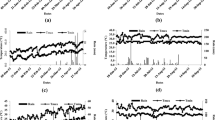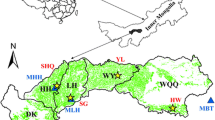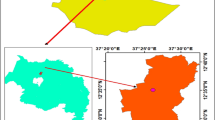Abstract
Water balance and migration characteristics are vital to the establishment of an efficient irrigation management system. Based on the observed data including microclimate and growing parameters of maize from 2009 to 2012, actual evapotranspiration during the growth period was estimated by a combination of the FAO-56 crop coefficient approach and the Penman–Monteith model; the changes in soil water storage were estimated through the monitored water content at different depths from 0 to 3 m; the water content monitoring zone was divided into three sub-zones according to the water-balance characteristics of different soil layers and water monitoring data. On these bases, in combination of water-balance model, three aspects were analyzed: water-balance characteristics at different growth stages; water-balance characteristics in the three different sub-zones; and water-migration characteristics of ten sunny days following irrigation. These analyses revealed severe deep leakage under present irrigation management, which could be remedied by limiting one-time irrigation practices and increasing irrigation frequency. Additionally, some practical suggestions are provided for different growing stages.





Similar content being viewed by others
Explore related subjects
Discover the latest articles, news and stories from top researchers in related subjects.References
Philip JR (1966) Plant water relations: some physical aspects. Annu Rev Plant Physiol 17:245–268
Panigrahi B, Panda SN (2003) Field test of a soil water balance simulation model. Agr Water Manag 58:223–240
Jalota S, Arora V (2002) Model-based assessment of water balance components under different cropping systems in north-west India. Agr Water Manag 57:75–87
Shang SH, Mao XM (2006) Application of a simulation based optimization model for winter wheat irrigation scheduling in North China. Agr Water Manag 85:314–322
Ji XB, Kang ES, Chen RS (2007) A mathematical model for simulating water balances in cropped sandy soil with conventional flood irrigation applied. Agr Water Manag 87:337–346
Baldocchi D, Meyers TP (1988) On using eco-physiological, micrometeorological and biogeochemical theory to evaluate carbon dioxide, water vapor and gaseous deposition fluxes over vegetation. Agr Forest Meteorol 90:1–26
Aubinet M, Grelle A, Ibrom A et al (1999) Estimation of the annual net carbon and water exchange of European forests: the EUROFLUX methodology. Adv Ecol Res 30:113–175
Verma SB (1990) Micrometeorological methods for measuring surface fluxes of mass and energy. Remote Sens Rev 5:99–115
German ER (2000) Regional evaluation of evapotranspiration in the Everglades. US Geological Survey, Virginia
Penman HL (1948) Natural evaporation from open water, bare soil and grass. Proc R Soc Lond Ser A Math Phys Sci 193:120–145
Monteith JL (1965) Evaporation and environment. Paper presented at symposia of society for experimental biology. Cambridge University, Cambridge, pp 205–234
Allen RG, Pereira LS, Raes D et al (1988) Crop evapotranspiration-guidelines for computing crop water requirements-FAO irrigation and drainage paper 56. Rome 300:6541
Allen RG (2000) Using the FAO-56 dual crop coefficient method over an irrigated region as part of an evapotranspiration intercomparison study. J Hydrol 229:27–41
Zhao LW, Ji XB (2010) Quantification of transpiration and evaporation over agricultural field using the FAO-56 dual crop coefficient approach—A case study of the maize field in an oasis in the middlestream of the Heihe River Basin in northwest China. Sci Agr Sin 43:4016–4026 (in Chinese)
Sun HY, Liu CM, Zhang XY et al (2006) Effects of irrigation on water balance, yield and WUE of winter wheat in the North China Plain. Agr Water Manag 85:211–218
Evett SR, Schwartz RC, Casanova JJ et al (2012) Soil water sensing for water balance, ET and WUE. Agr Water Manag 104:1–9
Han SJ, Hu HP, Yang DW (2011) Irrigation impact on annual water balance of the oases in Tarim Basin, northwest China. Hydrol Process 25:167–174
Skhiri A, Dechmi F (2012) Impact of sprinkler irrigation management on the Del Reguero river (Spain). I: water balance and irrigation performance. Agr Water Manag 103:120–129
Shang SH, Li XC, Mao XM et al (2004) Simulation of water dynamics and irrigation scheduling for winter wheat and maize in seasonal frost areas. Agr Water Manag 68:117–133
Milly PCD (1994) Climate, soil water storage, and the average annual water balance. Water Resour Res 30:2143–2156
Eitzinger J, Stastna M, Zalud Z et al (2003) A simulation study of the effect of soil water balance and water stress on winter wheat production under different climate change scenarios. Agr Water Manag 61:195–217
Daly E, Porporato A (2006) Impact of hydroclimatic fluctuations on the soil water balance. Water Resour Res 42:W06401
Hickel K, Zhang L (2006) Estimating the impact of rainfall seasonality on mean annual water balance using a top–down approach. J Hydrol 331:409–424
Chen C, Wang EL, Yu Q (2010) Modelling the effects of climate variability and water management on crop water productivity and water balance in the North China Plain. Agr Water Manag 97:1175–1184
Schilling KE, Jha MK, Zhang YK et al (2008) Impact of land use and land cover change on the water balance of a large agricultural watershed: historical effects and future directions. Water Resour Res 44:W00A09
Yang DW, Shao WW, Yeh PJF et al (2009) Impact of vegetation coverage on regional water balance in the nonhumid regions of China. Water Resour Res 45:W00A14
Li D, Pan M, Cong ZT et al (2013) Vegetation control on water and energy balance within the Budyko framework. Water Resour Res 49:969–976
Wang TJ, Istanbulluoglu E, Lenters J et al (2009) On the role of groundwater and soil texture in the regional water balance: an investigation of the Nebraska Sand Hills, USA. Water Resour Res 45:W10431
Liu Y, Teixeira J, Zhang H et al (1998) Model validation and crop coefficients for irrigation scheduling in the North China Plain. Agr Water Manag 36:233–246
George B, Shende S, Raghuwanshi N (2000) Development and testing of an irrigation scheduling model. Agr Water Manag 46:121–136
Mateos L, Lopez-Cortijo I, Sagardoy JA (2002) SIMIS: the FAO decision support system for irrigation scheme management. Agr Water Manag 56:193–206
Yazaki T, Urano S, Yabe K (2006) Water balance and water movement in unsaturated zones of Sphagnum hummocks in Fuhrengawa Mire, Hokkaido, Japan. J Hydrol 319:312–327
Singh R, Singh J (1997) Irrigation planning in wheat (Triticum aestivum) under deep water table conditions through simulation modelling. Agr Water Manag 33:19–29
Van Dam J, Feddes R (2000) Numerical simulation of infiltration, evaporation and shallow groundwater levels with the Richards equation. J Hydrol 233:72–85
Mastrocicco M, Colombani N, Salemi E et al (2010) Numerical assessment of effective evapotranspiration from maize plots to estimate groundwater recharge in lowlands. Agr Water Manag 97:1389–1398
Hajilal M (1998) Planning intra-seasonal water requirements in irrigation projects. Agr Water Manag 37:163–182
Kang ES (2004) Water resources relating to desertification in the Hexi area of Gansu Province, China. J Glaciol Geocryol 26:657–667 (in Chinese)
Ren JH (2005) Effects of water resources exploitation on eco-environment of Heihe River Basin. B Soil Water Conserv 25:94–96 (in Chinese)
Guo QL, Feng Q, Li JL (2009) Environmental changes after ecological water conveyance in the lower reaches of Heihe River, northwest China. Environ Geol 58:1387–1396
Cheng GD (2002) Study on the sustainable development in Heihe River watershed from the view of ecological economics. J Glaciol Geocryol 24:335–343 (in Chinese)
Li BG, Gong SY, Zuo Q et al (2000) Dynamic models and its application of soil water in farmland. Science Press, Beijing (in Chinese)
Lei ZD (1988) Soil water dynamics. Tsinghua University Press, Beijing (in Chinese)
Acknowledgements
We greatly appreciate the great help from Xibin Ji, Shoubo Li and Bowen Jin. This work was supported by the National Science Fund for Distinguished Young Scholars of China (41125002) and the National Natural Science Foundation of China (41271036).
Conflict of interest
The authors declare that they have no conflict of interest.
Author information
Authors and Affiliations
Corresponding author
About this article
Cite this article
Zhao, L., Zhao, W. Water balance and migration for maize in an oasis farmland of northwest China. Chin. Sci. Bull. 59, 4829–4837 (2014). https://doi.org/10.1007/s11434-014-0482-4
Received:
Accepted:
Published:
Issue Date:
DOI: https://doi.org/10.1007/s11434-014-0482-4




